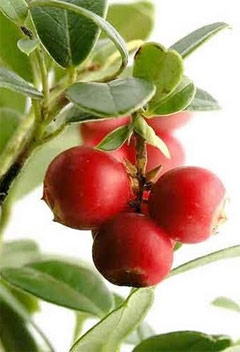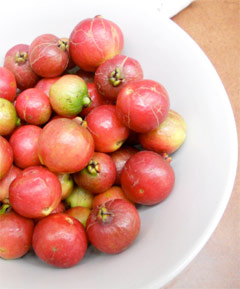|
|
|
 , ,
Font size |
Camu Camu: Miraculous Endangered Fruit from Peru

Camu-Camu is the name of a bush which grows in the Amazonian rain forest of
Peru. The Camu-Camu bush produces a fruit with the same name which contains
powerful phytochemicals with health benefits, including the amino acids serine,
valine, and leucine, and more Vitamin C than any other known plant in the world.
The camu-camu fruit has a surprising range of therapeutic effects. Botanical
name of Camu Camu is Myrciaria dubia.
Camu Camu berries are picked and dried at a low temperature. These dried berries
are then ground into a super fine powder, making it an easy addition to your
super food beverages and desserts. Since camu camu has a very sour flavour, the
berries are not typically consumed as a whole food.
Camu camu, camucamu, cacari, and camocamo, is a small (approx. 3�5 m tall) bushy
riverside tree from the Amazon rainforest vegetation in Peru and Brazil, which
bears a red/purple cherry-like fruit. It is a close relative of the jaboticaba (Myrciaria
cauliflora) and the guavaberry or rumberry (Myrciaria floribunda). The
extraordinarily high Vitamin C content (in the order of 2�3% of fresh weight) is
the most important property of the fruit, which has been exploited in
positioning camu camu on international markets.
Camu camu has small flowers with waxy white petals and a sweet-smelling aroma.
It has bushy feathery foliage. The evergreen, opposite leaves are lanceolate to
elliptic. Individual leaves are 3�20 cm in length and 1�2 cm wide.
The current range of camu camu comprises the Amazonian lowlands of Colombia,
Ecuador, Peru, Bolivia and Brazil. The distribution of camu camu extends from
the centre of Par� state, Brazil, along the mid and upper Amazon River to the
eastern part of Peru; in the north it appears in the Casiquiare and the upper
and middle Orinoco River. In Brazil it is found in Rond�nia along the Ma�angana
and Urupa Rivers and in Amazonas, in the municipalities of Manaus and Manacapuru
and along the Javar�, Madeira and Negro Rivers.
Long used by native peoples, wild camu camu fruit is harvested directly into
canoes. The fruit has only recently come into large-scale cultivation and sale
to the world market with Japan being the major buyer. It is relatively easy to
cultivate. It survives best in hot, damp tropical climates but will grow in the
subtropics, surviving temperatures down to just above freezing. It requires
copious water. Fair trade is present in low-land production from the Association
of Camu Camu Producers of the Peruvian Amazon.
Preliminary research suggests that camu camu may offer certain health benefits.
1) Inflammation: A study in Journal of Cardiology.
Camu camu may fight inflammation and oxidative stress, according to a 2008 study
from the Journal of Cardiology. For the study, 20 male smokers either drank camu
camu juice or took vitamin C tablets every day for a week. At the end of the
treatment period, members of the camu camu group showed a significant decrease
in certain markers of inflammation and oxidative stress. Members of the vitamin
C group, meanwhile, did not experience a decrease in these markers.
2) Diabetes: A study in Journal of Agricultural and Food Chemistry.
Camu camu shows potential in the treatment of diabetes, a 2010 study from the
Journal of Agricultural and Food Chemistry shows. In lab experiments, scientists
found camu camu to contain high amounts of antioxidants and ellagic acid (a
substance shown to offer anti diabetic effects in some research).
Common Uses for Camu Camu:
Proponents claim that camu camu can boost the immune system, aid in skin
care, and preserve eye health. In addition, camu camu is purported to protect
against the following
health problems: arthritis, atherosclerosis, cancer, depression, diabetes and
gum disease.
Camu camu is touted as a top source of vitamin C, an antioxidant vitamin often
used to strengthen the immune system. Although there is limited research on camu
camu's
vitamin C content, findings from some laboratory studies indicate that camu camu
pulp contains a high amount of vitamin C. There's also some evidence that camu
camu may be
high in anthocyanins, another type of antioxidant.
Health benefits of Camu Camu :
Vitamin C
 Camu
camu is chock full of vitamin C: 60 times more per serving than an orange! A
teaspoon of camu camu powder has 1180 per cent of your recommended daily intake
for Camu
camu is chock full of vitamin C: 60 times more per serving than an orange! A
teaspoon of camu camu powder has 1180 per cent of your recommended daily intake
for
vitamin C, which is important for gum health, among other functions in our body.
Valine
Valine is an amino acid found in camu camu. It's an essential amino acid,
meaning that we must get it in food because our bodies can't produce it. Valine
is used by the body to
prevent muscle breakdown and is important for nervous system and cognitive
function.
Potassium
Our bodies need potassium for the proper functioning of the heart and kidneys.
Camu camu is one way to get it: 71.1 milligrams are found in every 100 grams.
Leucine
This is another essential amino acid found in camu camu, one that our bodies
need for muscle and bone tissue growth and recovery and the production of growth
hormones.
Serine
Another amino acid! This one is key for digestion: serine helps to break down
the bonds in proteins and polypeptides so they can be used by our bodies.
Flavonoids
Camu camu has several different flavonoids, which are compounds that are found
in plants and are part of what gives fruits and vegetables their awesome
colours. They mostly
function in the body as antioxidants, neutralizing harmful free radicals.
Gallic Acid
Gallic acid is found in camu camu, which is good news because it appears to have
anti-fungal and anti-viral properties. It also acts as an antioxidant.
Ellagic Acid
This is another acid with antioxidant properties, found in camu camu. It's been
studied for anti-cancer effects, though research is still very early. Some
research also indicates that
ellagic acid has anti-diabetes effects.
Inflammation
As stated above in one study, 20 male smokers drank camu camu juice or took
vitamin C tablets daily for a week. The group who took camu camu showed a
decrease in some
markers for antioxidants and oxidative stress at the end of the study, compared
to no change for those who had vitamin C tablets.
Chemical Analysis of Camu-Camu
The following amounts per 100 grams of chemical compounds were found in an
analysis of 430 grams of spray-dried Camu-Camu powder (Royal Camu Powder):
-
Moisture 2.41 g.
-
Ash 1.01 g.
-
Fat 2.62 g.
-
Protein 1.55 g.
-
Fibre 0.76 g.
-
Total Carbohydrate 92.71 g.
-
Reducing Sugars 70.84 g.
-
Non-reducing Sugars 18.47 g.
-
Glucose 18.33 g.
-
Lactose 0.47 g.
-
Maltose 22.27 g.
-
Sucrose 18.00 g.
-
Starch 58.01 g.
-
Potassium 9.71 g.
-
Calcium 4.27 mg.
-
Phosphorus 35.14 mg.
-
Iron 0.94 mg.
-
Vitamin C 10.20 g. *
-
Vitamin B2 0.16 mg.
-
Vitamin B1 0.07 mg.
-
Niacin 8.25 mg.
Warnings: There is some concern that camu camu can interfere with some
chemotherapy medications�you should always let your doctor know about the
supplements you are
taking, but especially so if you are receiving chemo.
Dated 29 July 2013
|
|
|
|
|
|
|









